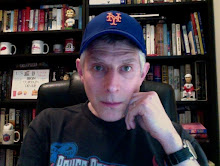 |
| The Silver Anniversary logo |
Searching for comparators, scribes turned to the Taj Mahal, Shah Jahan's edifice on the Yamuna River in India, perhaps forgetting it was a tomb for the Mughal emperor's wife.
Or maybe they didn't forget, for Dodger Stadium too is something of a monument, a grave marker for the poor mostly Mexican-American neighborhoods wiped from existence during a decade-long battle between liberal and conservative forces over what to do with acres upon acres of hilly land north of downtown L.A., a place called Chavez Ravine.
Stadium construction wasn't how that story started, but that's how it ended, with an ironic coup de grace from the team that integrated baseball.
 |
| July 21, 1987, St. Louis Cardinals 6, L.A. Dodgers 1 Winning pitcher, Bob Forsch, Loser, Fernando Valenzuela |
I knew none of this 30 years ago this week when I made my one and only visit to Dodger Stadium on the second stop of a two-week, six-ballpark road trip. (Read about stop one here.) Though it was the stadium's 25th anniversary season, the commemorative program and yearbook made no mention of what transpired in the years before the ballpark opened. It was a story they had no incentive to publicize or perpetuate and, to be fair, for which they were largely not responsible.
Much has been written since about what came to be known as the Battle of Chavez Ravine, including a new book published just this year. It went something like this:
 |
| The Joe Friday ticket stub. |
Los Angeles was no exception and it was proposed that the Chavez Ravine area be redeveloped into something called Elysian Park Heights. The project would include two dozen high-rise apartment buildings and more than 160 two-story residences.
Though the communities there -- Palo Verde, Bishop and La Loma -- had homes, schools and at least one church, they weren't seen as worthy of preservation. The city moved by force of eminent domain to begin clearing those so-called slums of the people and their dwellings. But before Elysian Park Heights construction could begin, in 1953, newly-elected conservative Mayor Norris Poulson -- with a push from a group called Citizens Against Socialized Housing (or CASH) -- canceled the project, leaving a handful of hold-out families living in a largely bulldozed region where they'd remain at loggerheads with L.A. for most of that decade.
In 1957, the Brooklyn Dodgers -- after trying and failing to secure a new stadium in their home borough -- won permission to move west with the Giants. They had no home, but Los Angeles had an idea. The city would trade its Chavez Ravine land to the team in exchange for a Dodger-owned downtown minor league ballpark confusingly called Wrigley Field.
 |
| Giants' shortstop Jose Uribe meets Dodger catcher Mike Scioscia |
The result: a baseball-only ballpark built into a hillside, facing the distant San Gabriel mountains visible beyond the twin outfield pavilions and scoreboards.
Led by pitchers Sandy Koufax and Don Drysdale, in just their second season there the team swept the American League Champion New York Yankees to win the World Series before about 56,000 home town fans. They'd win the series in '65, '81 and '88 too.
Along the way, the team that gave America Jackie Robinson, its first black superstar, also gave the nation its first Japanese superstar, Hideo Nomo and -- perhaps in a bit of karmic payback -- its first Mexican one, Fernando Valenzuela.
_____________________________
In the Summer of 1987, soon after graduating from college, me and my buddy Chris took a baseball tour of California. Mostly baseball at least, and hell of a good time. This is the second part of a series inspired by those 16 days on the road.

No comments:
Post a Comment